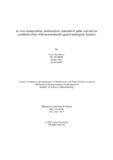In vitro antimicrobial, antihemolytic potential of gallic acid and its combined effect with metronidazole against pathogenic bacteria
| dc.contributor.advisor | Shakil, Md. Salman | |
| dc.contributor.advisor | Hossain, Mahboob | |
| dc.contributor.author | Chowdhury, Arav | |
| dc.contributor.author | Afroz, Amrin | |
| dc.date.accessioned | 2023-07-20T10:20:54Z | |
| dc.date.available | 2023-07-20T10:20:54Z | |
| dc.date.copyright | 2022 | |
| dc.date.issued | 2022-11 | |
| dc.identifier.other | ID 18136090 | |
| dc.identifier.uri | http://hdl.handle.net/10361/18955 | |
| dc.description | This thesis is submitted in partial fulfillment of the requirements for the degree of Bachelor of Science in Biotechnology 2022. | en_US |
| dc.description | Catalogued from PDF version of thesis. | |
| dc.description | Includes bibliographical references (pages 53-58). | |
| dc.description.abstract | Multidrug-resistant (MDR) or extensive drug-resistant (XDR) pathogenic bacteria pose a grave threat to human and animal health on a global scale. Plant-derived phytochemicals including alkaloids, flavonoids, and terpenoids reported having antimicrobial activity against UTI, dysentery, and diarrhea-causing pathogenic bacteria. More importantly, natural compounds (e.g. gallic acid) alone or in a combination with FDA-approved antibiotics can be used to target resistant pathogenic bacteria. In our study, Gallic acid’s minimum inhibitory concentration was measured at 1600±28.87, 650±28.87, 675±14.53, 187.5±17.24, 295±24.27, 737.5±20.21, 1500±28.87, 1000±28.87, 550±14.529 μg/mL against E. coli ATCC 25922, Staphylococcus aureus, Enterococcus faecalis, Proteus vulgaris, Shigella flexneri, Shigella dysenteriae, Enteropathogenic E. Coli, Hafnia alvei, and Bacillus Cereus respectively. Co-administration of metronidazole and GA exhibited additivity in E. Coli, Enteropathogenic E. Coli, Bacillus cereus, Shigella flexneri, Shigella dysenteriae, Staphylococcus aureus, and Hafnia Alvei (FIC index at 0.84, 0.65, 0.76, 0.98, 0.76, 0.89, 0.76) while Enterococcus faecalis, Proteus vulgaris was indifferent. Furthermore, we have explored the in vitro hemocompatibility of various concentrations of GA in all the human blood groups (male and female) that demonstrated exceptional hemocompatibility. Our results suggest that GA has significant potentiating activity in combination with metronidazole. GA decreases metronidazole’s MIC significantly when applied together, which can be a promising factor for AMR control. | en_US |
| dc.description.statementofresponsibility | Arav Chowdhury | |
| dc.description.statementofresponsibility | Amrin Afroz | |
| dc.format.extent | 58 pages | |
| dc.language.iso | en | en_US |
| dc.publisher | Brac University | en_US |
| dc.rights | Brac University theses are protected by copyright. They may be viewed from this source for any purpose, but reproduction or distribution in any format is prohibited without written permission. | |
| dc.subject | Antimicrobial Resistance (AMR) | en_US |
| dc.subject | Gallic acid | en_US |
| dc.subject | Minimum Inhibitory Concentration (MIC) | en_US |
| dc.subject | Fractional Inhibitory Concentration (FIC) | en_US |
| dc.subject | Synergy | en_US |
| dc.subject.lcsh | Anti-infective agents | |
| dc.subject.lcsh | Drug resistance | |
| dc.title | In vitro antimicrobial, antihemolytic potential of gallic acid and its combined effect with metronidazole against pathogenic bacteria | en_US |
| dc.type | Thesis | en_US |
| dc.contributor.department | Department of Mathematics and Natural Sciences, Brac University | |
| dc.description.degree | B. Biotechnology |

